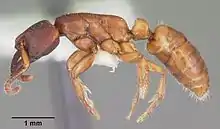Promyopias
Promyopias is an Afrotropical genus of ant in the subfamily Ponerinae containing the single species Promyopias silvestrii.[1] The rare genus has previously been regarded as a separate genus, as a subgenus and as a provisional synonymy, but was reinstated at genus-rank in 2008.
| Promyopias | |
|---|---|
 | |
| Promyopias silvestrii worker from the Ivory Coast | |
| Scientific classification | |
| Domain: | Eukaryota |
| Kingdom: | Animalia |
| Phylum: | Arthropoda |
| Class: | Insecta |
| Order: | Hymenoptera |
| Family: | Formicidae |
| Genus: | Promyopias Santschi, 1914 |
| Species: | P. silvestrii |
| Binomial name | |
| Promyopias silvestrii (Santschi, 1914) | |
| Synonyms | |
|
Myopias silvestrii Santschi, 1914 (type species) | |
Description
Promyopias, known from the Afrotropics, is uncommon but widely distributed. Its diet, presumably termites but not actually demonstrated, may be more restricted or specialized than in Centromyrmex. The morphology of the mandible is unique and immediately identifies Promyopias silvestrii. Males are unknown.[2]
Taxonomy
Santschi (1914) initially associated Promyopias with Myopias,[3] the latter a moderately sized genus widespread in the Oriental, Malesian and Austral regions, because of supposed overall similarities in the form of the mandible and clypeus. It now seems certain that these similarities are the result of convergence through the development of similar predatory behaviors and life styles in the two genera. Major characters of Myopias that differentiate it from Promyopias include: eyes usually present in worker (absent in one species); scape not flattened; mesonotum sharply defined; spiniform setae entirely absent from middle and hind tibiae and basitarsi; helcium located at base of first gastral segment; posterodorsal margin of helcium with a median emargination; prora an anteroventral tooth; stridulitrum present.[4]
During its history Promyopias has been regarded as a separate genus or as a subgenus of two other ponerine genera. The provisional synonymy of Promyopias with Centromyrmex proposed by Brown (1973)[5] and accepted by Bolton (1994, 2003)[6][7] was based on the presence and distribution of spiniform setae on the legs. Bolton & Fisher (2008) formally reinstated Promyopias at genus-rank.[8]
References
- "Genus: Promyopias". antweb.org. AntWeb. Retrieved 23 September 2013.
- Bolton & Fisher 2008, p. 31
- Santschi 1914, p. 323
- Bolton & Fisher 2008, p. 30
- Brown 1973, p. 184
- Bolton 1994, p. 164
- Bolton 2003, p. 160
- Bolton & Fisher 2008, p. 28
- Bolton, B. (1994), Identification Guide to the Ant Genera of the World, 222 pp. Cambridge, Ma.
- Bolton, B. (2003), "Synopsis and classification of Formicidae.", Memoirs of the American Entomological Institute, 71: 1–370
- Bolton, Barry; Fisher, Brian L. (2008), "Afrotropical ants of the ponerine genera Centromyrmex Mayr, Promyopias Santschi gen. rev. and Feroponera gen. n., with a revised key to genera of African Ponerinae (Hymenoptera: Formicidae)" (PDF), Zootaxa, 1929: 1–37, doi:10.11646/zootaxa.1929.1.1
- Brown, W.L., Jr. (1973), A comparison of the Hylean and Congo-West African rain forest ant faunas. In Meggers, B.J., Ayensu, E.S. & Duckworth, W.D. (eds.). Tropical Forest Ecosystems in Africa and South America: a Comparative Review, pp. 161–185
{{citation}}: CS1 maint: multiple names: authors list (link) - Santschi, F. (1914), "Formicides de l'Afrique occidentale et australe du voyage de Mr. le Professeur F. Silvestri.", Bollettino del Laboratorio di Zoologia Generale e Agraria della R, Scuola superiore d'Agricoltura in Portici, 8: 309–385
 This article incorporates text from a scholarly publication published under a copyright license that allows anyone to reuse, revise, remix and redistribute the materials in any form for any purpose: Bolton, Barry; Fisher, Brian L. (2008), "Afrotropical ants of the ponerine genera Centromyrmex Mayr, Promyopias Santschi gen. rev. and Feroponera gen. n., with a revised key to genera of African Ponerinae (Hymenoptera: Formicidae)" (PDF), Zootaxa, 1929: 1–37, doi:10.11646/zootaxa.1929.1.1 Please check the source for the exact licensing terms.
This article incorporates text from a scholarly publication published under a copyright license that allows anyone to reuse, revise, remix and redistribute the materials in any form for any purpose: Bolton, Barry; Fisher, Brian L. (2008), "Afrotropical ants of the ponerine genera Centromyrmex Mayr, Promyopias Santschi gen. rev. and Feroponera gen. n., with a revised key to genera of African Ponerinae (Hymenoptera: Formicidae)" (PDF), Zootaxa, 1929: 1–37, doi:10.11646/zootaxa.1929.1.1 Please check the source for the exact licensing terms.
External links
 Media related to Promyopias silvestrii at Wikimedia Commons
Media related to Promyopias silvestrii at Wikimedia Commons